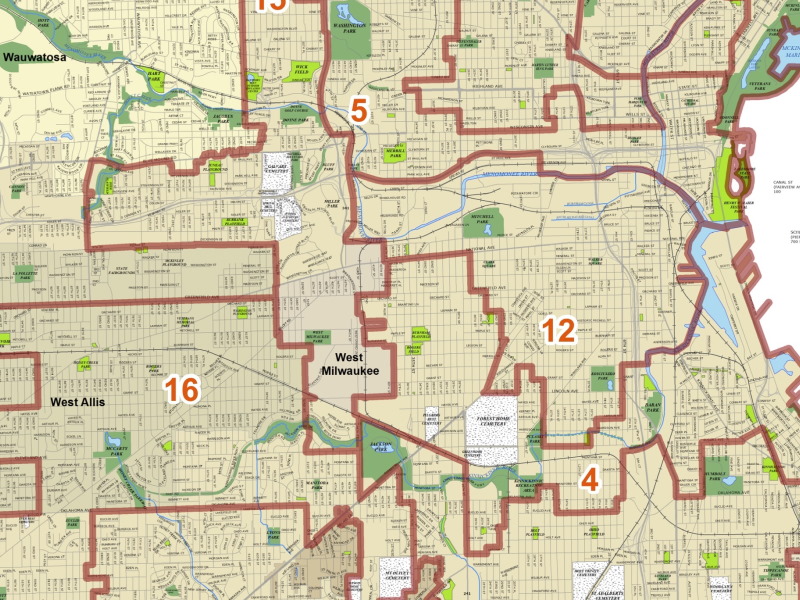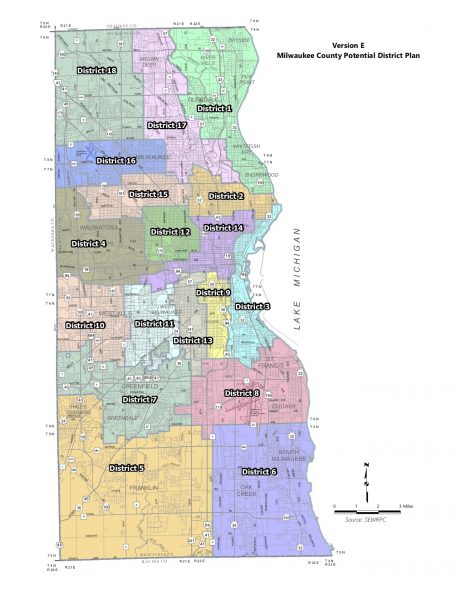Hispanic Districts Key to Board Redistricting
Current Hispanic districts potentially run afoul of 1965 Voting Rights Act.
The next district map for the Milwaukee County Board of Supervisors could, for the first time, include two districts on the South Side that have solid Hispanic majorities. And the change could substantially alter the board’s power dynamics.
Typically, it is the legislative bodies that redraw their own districts every 10 years using census data. But, for the first time, the Milwaukee County supervisory districts are being drawn by an independent committee appointed by the board.
The IRC put a priority on honoring the intent of the 1965 Voting Rights Act, and recognition of racial and ethnic communities of interest. The Hispanic population in Milwaukee County increased by 21% during the past decade to 16.3% of all residents. Meanwhile, white residents, who currently have 10 supervisors on the 18 member board, lost population over the last decade. With that in mind, the committee sought to draw two districts where Hispanic residents were the majority.
There are actually already two districts on the county board with Hispanic majorities. District 4, represented by Sup. Ryan Clancy, and District 12, represented by Sup. Sylvia Ortiz-Velez.
But one of them, District 4, had a Hispanic majority of only 56%. The case law regarding racial and ethnic majority districts would call this an “influence district” not a majority-minority district. It includes a significant chunk of the Hispanic-dominated Near South Side as well as the northern piece of the majority-white neighborhood of Bay View. Over the past decade, the Hispanic population in this district grew to more than 60%, according to data from the 2020 Census.
Yet, in 2020, Clancy, who is white, defeated Andrea Rodriguez, despite winning zero Hispanic majority wards, and only winning seven of the 26 wards in the district. Rodriguez was the first Hispanic candidate for the seat since the county board drew the district in 2011. She won 19 wards and every Hispanic majority ward.
Ortiz-Velez, who represents District 12 on the county board – the only district that meets the legal definition of a Hispanic majority district – provided public comments to the IRC saying that both District 4, and her own, are examples of white vote dilution of a minority vote and “a serious violation of the Voting Rights Act.”
In public comment to the IRC, Ortiz-Velez said that a single majority-white ward in her district represents 24% of the turnout. She noted that this ward is east of Interstate 94 and represents a distinct community that is whiter and wealthier than the majority of her district, but has a “disproportionate electoral impact that dilutes the voting power and political voice of Milwaukee’s Latino community.”
She wants two true majority-Hispanic districts, even if she won’t represent either of them. Ortiz-Velez, as of January, is a representative in the Wisconsin State Assembly, and has said she will not seek re-election to the county board in 2022.
The IRC deliberated over whether or not to create two or three Hispanic majority districts in the county. But ultimately opted for two that have a strong Hispanic majority. The new map also creates six majority Black districts, one majority non-white district and nine majority white districts.
The two Hispanic districts created by the IRC would be called District 9 and District 13. District 9 would have a Hispanic majority of more than 70%, and the voting age population, or those 18 years and older, would be 67% Hispanic. District 13 would be approximately 67% Hispanic with a voting-age population that is 62% Hispanic.
Kevin Muhs, executive director of the Southeast Wisconsin Regional Planning Commission, explained at an IRC meeting on Sept. 15, that three districts could be drawn Hispanic majority of just over 50%. “But then we run into the issue that then none of them are actually, really empowering Hispanic populations,” he said. SEWRPC is providing technical assistance to the IRC’s redistricting process.
The empowerment issue comes from a court decision on the case Baldus v. Members of the Wis. Government Accountability Board. The resulting case law establishes that districts with a majority “hovering around 50%,” as DiMotto, chair of the IRC put it, do not legally constitute a majority-minority district.
But with the creation of the two new strong-majority Hispanic districts, and adherence to other common redistricting principles, the IRC has created a new map that would reshape the 18-member board. One of the new districts it has created, running along Milwaukee’s lakefront, has three sitting supervisors living in it.
The board now faces a tight timeline to review and modify the proposed districts. It is already a half month behind schedule, putting the municipalities — which must wait for the county map — even further behind schedule.
The board will next meet on Oct. 1. And when it does it must reckon with the fact that is behind schedule on adopting a new map, that the current map is potentially illegal under the Voting Rights Act and that the recommended new map will result in some supervisors either having to move or compete to stay in office.
The full process, including the underlying municipal maps, needs to be completed by Nov. 23.
If the board doesn’t act and a court challenge comes, a judge could step in to draw the new map.
For more on the process, see our coverage from Wednesday.
If you think stories like this are important, become a member of Urban Milwaukee and help support real, independent journalism. Plus you get some cool added benefits.
More about the Milwaukee County redistricting process
- Op Ed: Muslim Community Needs Representation - Janan Najeeb - Jan 29th, 2022
- City Hall: Council Ends Redistricting With Anger, Tears - Jeramey Jannene - Jan 18th, 2022
- Statement from Milwaukee Mayor Cavalier Johnson - Mayor Cavalier Johnson - Jan 18th, 2022
- City Hall: Latino Leaders Could Sue Over Redistricting - Jeramey Jannene - Jan 14th, 2022
- Latinx Leaders Condemn Common Council’s Refusal to Draw New Districts Reflecting Dramatic Growth of Latinx Population; Demand Second Legal Opinion - Voces de la Frontera - Jan 14th, 2022
- Voces de la Frontera Statement on Redistricting Decision - Voces de la Frontera - Jan 11th, 2022
- Statement on redistricting decision - JoCasta Zamarripa - Jan 10th, 2022
- City Hall: Milwaukee Starts Over On Redistricting, Only To Adopt Same Map Again - Jeramey Jannene - Jan 10th, 2022
- Statement by Milwaukee Mayor Tom Barrett: - Mayor Tom Barrett - Dec 14th, 2021
- City Hall: Council Halts Redistricting After Latino Pushback - Jeramey Jannene - Dec 14th, 2021
Read more about Milwaukee County redistricting process here
Political Contributions Tracker
Displaying political contributions between people mentioned in this story. Learn more.
MKE County
-
Ron Johnson Says Free-Market Principles Could Fix Education
 Jul 17th, 2024 by Graham Kilmer
Jul 17th, 2024 by Graham Kilmer
-
RNC Will Cause Some County Services To Be Moved to Wauwatosa
 Jul 12th, 2024 by Graham Kilmer
Jul 12th, 2024 by Graham Kilmer
-
Hank Aaron State Trail Will Be Closed For RNC, State Fair
 Jul 12th, 2024 by Graham Kilmer
Jul 12th, 2024 by Graham Kilmer























